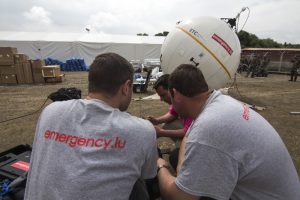
SES offers a broad range of solutions to support humanitarian and disaster relief efforts across the globe. Some of them were showcased during the Humanitarian ICT (Information and Communications Technology) Forum organised by the United Nations Office for the Coordination of Humanitarian Affairs (OCHA) and Emergency Telecommunications Cluster (ETC), and held on the 21 and 22 March, 2017, in Mountain View, California.
SES’s satellite solutions can help to restore essential communication links, ensuring immediate coverage via capacity reserved for relief efforts and support for multiple end-to-end humanitarian services.
Emergency.lu, a multi-layer platform, which includes a portable Rapid Deployment Kit delivering connectivity via SES satellites, has been devised to support first responders’ efforts. In past years, the platform, which is supported by a public private partnership between the Luxembourg government and three Luxembourg-based companies (SES, HITEC Luxembourg and Luxembourg Air Ambulance), and in collaboration with the World Food Programme (WFP), Emergency Telecommunications Cluster and Ericsson Response, has been deployed in many emergency situations around the world, including Haiti, Nepal and Vanuatu, and earlier in Mali, the Philippines, South Sudan, Venezuela and Ebola-affected countries in West Africa.
SES’s capabilities go beyond enabling quick humanitarian relief efforts and supporting the immediate needs of first responders. At this year’s Humanitarian ICT Forum, SES unveiled its new SATCOM-enabled solution, Government+ Rapid Response Vehicle (RRV). Using a combination of GEO (Geostationary Earth Orbit) and MEO (Medium Earth Orbit) satellite connectivity, RRV can enable wireless internet access for refugee camps and communities, reinforce downed public infrastructure, and provide IP backhaul for mobile networks and long-term connectivity for agencies on the ground. High-definition video conferencing, streaming, GSM backhaul, cloud-based services and high-speed broadband in locations where infrastructure is non-existent or destroyed – are only a few of the applications the RRV can provide.
“SES’s launch of the Government+ Rapid Response Vehicle is a natural and exciting extension of our team’s vast experience and the technological advancements SES has honed for decades in support of humanitarian efforts around the globe,” explained Nicole Robinson, Head of Government Market Solutions Centre at SES. “Whether these are aid missions in response to natural or technological disasters or humanitarian operations, our RRV platform can provide tailored multi-band, multi-orbit connectivity to support virtually any situation imaginable, anywhere in the world.”
The plug-and-play modular RRV solution can easily integrate and deploy an array of communications technologies and devices aboard its mobile vehicle, including the emergency.lu disaster recovery platform, SES Government+ persistent surveillance aerostat or SATMED telemedicine service. The RRV is equipped with wireless capabilities, including MIMO (Multiple Input Multiple Output) SDR radio technology that provides humanitarian aid teams with an expansive mesh type, frequency programmable, mobile communications platform that supports private 3G and 4G LTE networks.
Original published at: https://spacewatch.global/2017/04/ses-enabling-disaster-response-connecting-affected-communities/
 SpaceWatch.Global An independent perspective on space
SpaceWatch.Global An independent perspective on space

